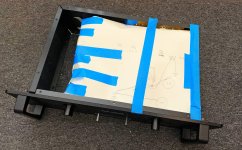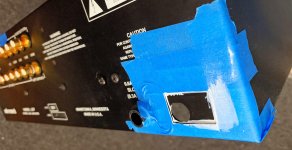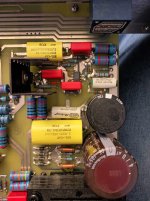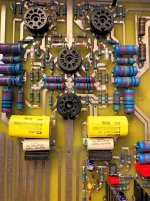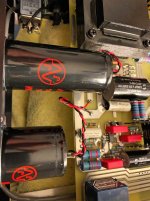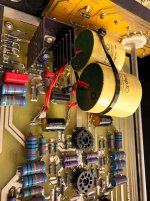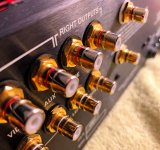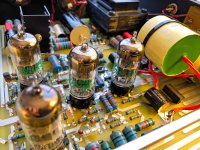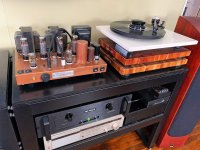Awhile back I posted about rebuilding an Audio Research LS1. I actually did two of them. From a what can you do with a bad condition piece to full restoration, this is a great thread: LS1 on DIYAudio.
But I had the chance to pick up an Audio Research LS7 in great condition. So I did. Here's what I did with it and how it compares to the LS1.
I bought 2 Audio Research LS1s as the start of a new system. The LS1 is a hybrid FET/Tube/MOSFET design, using a 6922 in the tube role. It is fully regulated on the 400V+ high-voltage B+ as well as the heater supply. The LS7 is very similar, the power supplies are very close, but only uses 1 semiconductor as a current source and four 6922 vacuum tubes in the gain and output stages.
The LS7 is a simpler preamp, despite having more tubes. Its cable routing is shorter, the PC board is less complex and it lacks switching and balance that the LS1 has. The LS7 being a little newer and being in spectacular condition, didn't require a great deal of work. The main change was to replace all the old electrolytic capacitors and upgrade the power supply film caps to Solen Metalized Polypropylene and the audio path capacitors to USA made Auricaps.
I drilled out the chassis for a proper IEC radio filtered receptacle. Many people are fans of the REL CAP and WONDER CAPS that Audio Research used back in the day, and I'm sure they were good at the time, but every modern manufactured capacitor I have from less than a dollar to $50 a pop sounds better. Manufacturing has changed capacitors as much from 1990s to now as from 1970s to 1990s REL CAPS. Don't keep these old caps. Replace them.
One thing I don't think was in my LS1 post, I ended up cutting out the original PC mount tube sockets and replaced them with new Belton Micalex ones. I haven't done that with the LS7 yet, but I probably will.
In replacing the 2 x 100uf electrolytics, I upgraded to cans/chassis mount instead of PC mount and used 800 and 350uf. The film went from 2 x 2uf to 6.8uf and 3uf on the power supply films.
Output capacitors are 2uf originally (5uf in the LS1) so I did the same as the LS1 and used a 6.8uf Auricap on the output.
The LS1 only has 1 output jack set, so I added a second for the subwoofer amp.
I am using 4 NOS Sylvania 6922s. That is the worst part of the LS7 - DC coupling and its very difficult tube requirements. See below.
Both preamps sound fantastic and are worthy of a place in any audiophile system. They are both excellent performers and the differences in the 2 are very subtle. I would imagine the LS1 is the best bet for most users, but the LS7 with some serious time spent matching high quality tubes can attain a slightly higher fidelity.
LS1
But I had the chance to pick up an Audio Research LS7 in great condition. So I did. Here's what I did with it and how it compares to the LS1.
I bought 2 Audio Research LS1s as the start of a new system. The LS1 is a hybrid FET/Tube/MOSFET design, using a 6922 in the tube role. It is fully regulated on the 400V+ high-voltage B+ as well as the heater supply. The LS7 is very similar, the power supplies are very close, but only uses 1 semiconductor as a current source and four 6922 vacuum tubes in the gain and output stages.
The LS7 is a simpler preamp, despite having more tubes. Its cable routing is shorter, the PC board is less complex and it lacks switching and balance that the LS1 has. The LS7 being a little newer and being in spectacular condition, didn't require a great deal of work. The main change was to replace all the old electrolytic capacitors and upgrade the power supply film caps to Solen Metalized Polypropylene and the audio path capacitors to USA made Auricaps.
I drilled out the chassis for a proper IEC radio filtered receptacle. Many people are fans of the REL CAP and WONDER CAPS that Audio Research used back in the day, and I'm sure they were good at the time, but every modern manufactured capacitor I have from less than a dollar to $50 a pop sounds better. Manufacturing has changed capacitors as much from 1990s to now as from 1970s to 1990s REL CAPS. Don't keep these old caps. Replace them.
One thing I don't think was in my LS1 post, I ended up cutting out the original PC mount tube sockets and replaced them with new Belton Micalex ones. I haven't done that with the LS7 yet, but I probably will.
In replacing the 2 x 100uf electrolytics, I upgraded to cans/chassis mount instead of PC mount and used 800 and 350uf. The film went from 2 x 2uf to 6.8uf and 3uf on the power supply films.
Output capacitors are 2uf originally (5uf in the LS1) so I did the same as the LS1 and used a 6.8uf Auricap on the output.
The LS1 only has 1 output jack set, so I added a second for the subwoofer amp.
I am using 4 NOS Sylvania 6922s. That is the worst part of the LS7 - DC coupling and its very difficult tube requirements. See below.
So How is the LS7 vs the LS1? Pros and Cons of Each Design
Both preamps sound fantastic and are worthy of a place in any audiophile system. They are both excellent performers and the differences in the 2 are very subtle. I would imagine the LS1 is the best bet for most users, but the LS7 with some serious time spent matching high quality tubes can attain a slightly higher fidelity.
LS1
- One tube is much cheaper; the solid state devices make having a premium tube not necessary. The circuit is very forgiving of the typical variations in vacuum tubes
- 20db gain vs 13db gain for LS7
- Solid state devices have lower output impedance and can drive solid state amps and longer cables better
- 6 inputs vs 5 on LS7
- Balance control
- Tighter, better low bass and extension
- Two output RCA jack sets
- Slightly better and more open soundstage; better depth and placement
- The internet rumor of 'lean bass' likely comes from the 2uf output capacitor driving solid state amps; increasing this I hear no lack of bass at all
- 13db of gain is fine for most systems; however, may not be enough with some equipment
- DC coupling from input to output makes the tube selection very, very, very tricky as each section difference is multiplied in the DC levels through the preamp; I saw as much as 70V difference from L to R channel on new tubes. The regulated B+ is only 225V. So...
- Tube selection and matching is critical because of above ... I had to do serious matching to get DC levels to match throughout
- The trade off for increased hassle of setup and lack of controls is simply a better sound
- Much, much more expensive to re-tube because of above
- Only has one RCA output set without modifying
Attachments
My experience with the Sylvania (and other ECG-branded 6922s) was not positive. NOS Tesla ECC88s can be not expensive, ~18 USD, if you shop around and they're generally quiet and reliable too. The ones with factory code 32 are preferred. The Teslas have a Mullard Blackburn ECC88 full and funky type of vibe that isn't as refined as say Amperex Holland ECC88s. The Amperexes can sound a bit too laid back in some equipment. YMMV
S.
S.
I bought a job lot of tubes recently and came across an unusual type ECC2000.
Gets a mention here ... DiyAudio - Cascode tubes as being an alternitive to the ECC88/6DJ8.
Seeing that it was an ideal audio tube plus being 10,000 hours, low noise and gold pins, I was thinking 'big bucks'. But according to Google they are just £10 NOS.
I just realised the snag - B10C base.
Gets a mention here ... DiyAudio - Cascode tubes as being an alternitive to the ECC88/6DJ8.
Seeing that it was an ideal audio tube plus being 10,000 hours, low noise and gold pins, I was thinking 'big bucks'. But according to Google they are just £10 NOS.
I just realised the snag - B10C base.
The triode sections in the ECC2000 are not 100 % identical; section 2 has a somehwat higher transconductance than section 1 (difference is 4 to 5 mA/V). So I would think that this difference limits the amount of ways you can use them for audio a bit.
As for the 10-pin base: Sockets for these tues are being sold in some internet shops (I bought some for a planned Aikido headphones amp with PCL200's, or even PFL200's).
As for the 10-pin base: Sockets for these tues are being sold in some internet shops (I bought some for a planned Aikido headphones amp with PCL200's, or even PFL200's).
I am not sure you guys aren't on to something. But I am on the reverse side. Sound wise anyways. In testing all these preamps I also tried the 5670 and I even tossed out the coin for the WE 2C51. In my aural tests, the GE 5670 and 2C51 as well as GE and Phillips 6DJ8s all sound the same. The Sylvanias do not. They sound better in my system, but maybe that is my system. It was very difficult to get a matched set too. I think I pointed out earlier these tubes are not as designed. But they have a smooth high end roll off and openness that really works in what I am building anyway. I do think and agree they are abnormal. At least from basic tests.
In the tube data the sections are described as 'input' and 'output' for cascode operation. I think it is just to ensure that the two halves are used as designed.The triode sections in the ECC2000 are not 100 % identical; section 2 has a somehwat higher transconductance than section 1 (difference is 4 to 5 mA/V). So I would think that this difference limits the amount of ways you can use them for audio a bit.
